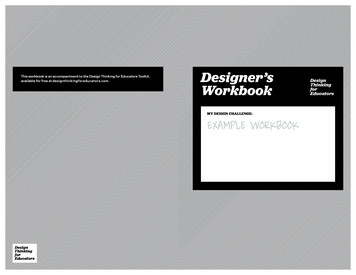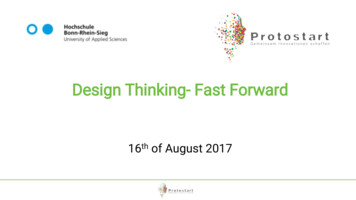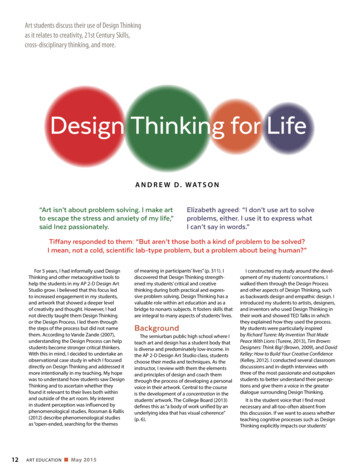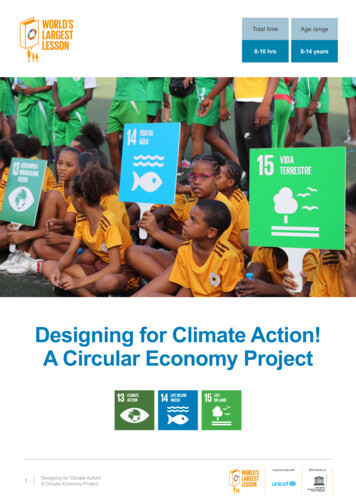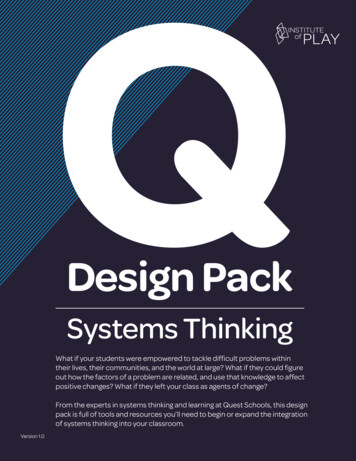
Transcription
DesignThinking forLearningProfessionalsby Sharon Boller &Laura FletcherBottom-Line Performance
Table of ContentsIntroduction3What is Design Thinking?8Find the “Sweet Spot”11What makes a “great” learningexperience?12Applying Design Thinking to L&D146 Steps to Success16Design Thinking Tools232
IntroductionLet’s pretend you’re going on vacation with your friend, Suzy. You tell Suzy toleave the planning to you. You want to ensure Suzy has a good vacation, so youagree on the timing, the climate, and the budget for the trip.You find a perfect hiking trip for the two of you. Suzy and you have done someday hikes before so you are confident she’ll love it. Your trip features daily 10mile hikes, tent camping, and backpacking your supplies. There are no showersor indoor bathrooms.Sounds perfect, right? You’ll truly be off the grid, a respite from the frenzy ofdaily life. or so you think.3
When Suzy arrives at the airport, youexcitedly share your destination anditinerary. To your surprise, a look ofhorror passes over Suzy’s face. Shehates camping. Worse, her idea of anactive vacation differs from yours.To her, a week consisting of somethree-mile hikes, a one-day bikerental, and time spent walking arounda seaside resort town is active. Shealso wants a hot shower and a clean,cozy bed every night. Finally, Suzy hasno desire to carry her food; she wantsit served in a restaurant.You thought you had good info onSuzy, but by failing to consult withher as you planned, you designed herworst nightmare of a vacation andyou also ruined your own. Bottom-Line Performance4
Are you thinking, “I would never do this. That’s ridiculous. Obviously,someone who is going on a vacation needs help to decide the destinationand the activities. Otherwise, it might be a bad experience for that person.This is a stupid, unrealistic example.”You’re right. It is stupid. Unfortunately, we all do different versions of thiskind of planning all the time. Especially in the workplace. Bottom-Line Performance5
Many learning professionals plan traininginitiatives without consulting the peoplethey’re planning them for. They fail toconsider the entire learning experiencefrom start to desired end point. As aresult, they don’t know what might makean experience magical for someone orwhat could make it utterly miserable.In many cases, they have no idea whatthe people they are planning for arethinking, feeling, seeing, hearing, or doingon a daily basis. This makes it incrediblydifficult to achieve a desired outcome thatmeets both the needs of the business andthe needs of the learner. As a result, thedesired business outcome is often notachieved.Instead, many trainers focus on what theyneed to communicate or get people to do. Bottom-Line Performance6
This eBook is designed to help you stop the crazy. It introduces a variety oftools to help you create a meaningful learning experience that adds valuefor learners while achieving business outcomes.It explains what design thinking is, how it can be used to craft learningsolutions, and five tools that can get you started with a design thinkingapproach. Bottom-Line Performance7
What Is Design Thinking?Design thinking is a human-centered approach tosolving problems. It has been used since the 1960s toresolve massive human challenges as well as to designsoftware solutions and consumer products.1“Design Thinking: A Method for Creative Problem Solving.” IDEO U. 2018.https://www.ideou.com/pages/design-thinking.1 Bottom-Line Performance8
In its original form, design thinking included five steps. Many practicioners have added a sixth step, implementation, fora highly iterative process that looks like this:Typical Design Thinking ProcessEmpathize Bottom-Line PerformanceDefineIdeatePrototypeTestImplement9
Design thinking assumes we won’t design the solutionto a problem the right way on the first go, and we’regoing to need to iterate. It also assumes the target usershould play a role in designing the optimal solution. Bottom-Line Performance11
Find the “Sweet Spot”User (human)desirabilityDesign thinking seeks to find the sweetspot between user, organization, andtechnology. Design thinking starts withthe user – or in our case, the learner –not the tasks we want them to do or theinfo we want them to know.Too often solution choices are drivenby two things: business viability andtechnology feasibility. The actual targetof the solution (aka the “user”) is oftennot part of the conversation whendecisions are made – at least in the L&Dworld.BusinessviabilityTechnologyfeasibility11
What makes a “great”learning experience?The simple definition of a great userexperience is one that delivers value to theuser (solves a problem they have), is easyto use, and is enjoyable to use.Think about Uber or Lyft and the app youuse to request a ride from either company.First, that service – as represented bythe app – solves a huge problem formany travelers: finding safe, reliabletransportation when taxis aren’t easilylocated.In Instructional Designtoday, theUser Experience (UX)Is often poorly designed.Second, the app is super easy to use andrequires no instructions. You can easilyfigure it out as you use it for the first time.Third, it’s enjoyable. You have the coollittle map with the image of the car asit works toward you. You can see whoyour driver is, how others have rated thatdriver, and exactly what your trip will costyou. You don’t have to tip or fumble withmoney. Those are all plusses that equate toenjoyable. Bottom-Line PerformanceWhy? Because learners aremostly absent from the designconversation.
Learning experiencesshould:Listening to OurLearnersProvide value tothe learner & theorganization.Be easy to useor access.Now think about your typical learningexperience. What problem does thatlearning experience solve for the learner,as opposed to the organization? Whatvalue does it provide for them?Many learning designers don’t think ofthings from the learner’s point of viewwhen they design training. Too frequently,decisions are made about the design ofthe learning experience with no “voice ofthe learner” available or considered.Subject matter experts and stakeholdersassume that role – and assume they knowwhat the learner wants, needs, and feels.They do not verify their assumptionsabout the learner. Decisions are based onbusiness needs only – without factoringin the experience of the learner at all.Decisions can also be made based onwhat technology a company already hason hand.Be enjoyable.13
What Does DesignThinking Look Like in L&D?Design thinkers are all about experiences – and theyknow experiences are more than events. They arejourneys with a starting point and an ending point.In the marketing world, marketers and productmanagers think about customer journeys all the time.They know that customers on a buying journey willexit it if they encounter too many barriers, can’t figureout what value the product will bring to them, or findthemselves confused.Learning is no different. It’s not an event; it’s ajourney with distinct steps within it. Your goal asa designer is to keep learners moving through thejourney by meeting their needs and providing valueat each step along the way.You may “force” a learner to a point. but you won’tget them to complete the journey if it is poorlydesigned. In other cases, you unintentionally mighthave designed an incomplete journey. You took thelearner halfway and never finished building the road. Bottom-Line Performance14
Unlike what may happen in a product development world, an L&D practitioner usually has someone coming to them asking for a solution. Theyaren’t trying to invent products. So, we think the design thinking model needs a bit of tweaking for the L&D world (but only a tweak).We believe the design thinking journey starts when someone defines a perceived problem or need. So – we move problem definition to thefront of the model and add a separate step for refining the problem. Empathize goes between those two stages. So our model adds a stage:Our Design Thinking ModelDefine Bottom-Line ment15
6 Steps to SuccessIt takes patience and practice to blend design thinkinginto our instructional design process. These six stepswill help you get started the right way. Bottom-Line Performance16
1. Get crystal clear onwhat problem you aretrying to solve.A simple “strategy blueprint” canhelp spark conversation about whatchallenges you’re trying to resolve, whatconstitutes success, and how you’llmeasure achievement of success. If youneed direction on how to put together astrategy blueprint, many online resourcesexist that can help you. Googling “strategyblueprints” gets you started.As you execute on the other five tipsbelow, refine your blueprint to keep italigned with your users as well as theorganization’s perspective. Bottom-Line Performance17
2. Create an empathy map ofyour learner(s).Your empathy map should focus on whatever taskor block of knowledge you are trying to get peopleto do or know about. Numerous digital tools areavailable for creating empathy maps, includingones that enable people to collaborate virtually. Abaseline map addresses questions in five areas:1. What is this learner thinking and feeling aboutX? (X whatever it is you want people to learnto do or to know about)2. What does the learner see and hear fromothers as they do X or apply knowledge of X intheir jobs?3. What does the learner do in relation to X? (Forexample, if the training is going to focus onselling a product, ask yourself what the salesrep (the learner) does in the job as he/shesells a product.)4. What are the learner’s pain points inattempting to do the task/apply knowledge?5. What are the motivators for doing the task/applying knowledge? Bottom-Line Performance18
3. Craft one or morelearner personas.Use the outputs of your mapping exerciseto craft one or more learner personas.These fictionalized representations ofyour learners focus you on the learners’primary challenges, motivators, and dailyrealities. Name your persona and makethem realistic.As you build your solution ask, “Whatwould (Persona Name) think of this?”When SMEs push you to include gobs ofcontent you feel is not relevant or useful,refer to the persona for some validation.“Would Suzy use this? Where would sheuse it?” Bottom-Line Performance19
4. Recognize learning as a journey,not an event.Use a learning journey map to discuss and plan the entirelearning process. We have crafted and trademarked a learningjourney that includes six steps that go from Step 1 “Notice”to Step 6 “Sustain.” Consciously connect what your empathymap has revealed about the learner with decisions about yoursolution. A journey map helps you specify these things:- The key activity or activities the learner will do within a step.- The emotions you want to elicit and the ones you want to avoidtriggering.- The desired outcome of a step so you can verify the activitiessupport the outcome.- Things that could make a step “magical” (perhaps by tapping intoone of the learner’s motivators or eliminating a challenge theyhave).- Things that can derail the journey and cause misery. (Theseopportunities for magic or misery can be found within theempathy map.)- What the organization must do to support the activities, maximizethe magic, and avoid the misery points.- Organizational obstacles that can threaten success or make anactivity hard to support.- Opportunities to leverage based on empathic understandingof the user. (Opportunities often emerge as part of empathymapping exercise.) Bottom-Line Performance20
5. Brainstorm ideas forsolving your problem.Create simple prototypes.Brainstorm possible activities or solutions.Create low-fidelity prototypes of learningactivities or tools, and let four to six targetlearners give you feedback on what’s delightfulabout the experience and what stinks. Letlearners (not just SMEs) suggest ways toimprove it.If you are designing a live workshop, yourprototype may simply be a narrative outline ofwhat the workshop will include and activitieslearners will do. If it’s an eLearning courseor digital experience, then prototype typicalscreens and key actions a user does within it.After you create your prototypes, get feedbackon them. Your goal is to get feedback on yoursolutions from the learners rather than justbuilding them and hoping for the best. Bottom-Line Performance21
6. Keep testing simple.Focus on three things you want testers toevaluate. This focus helps keep SMEs fromgetting lost in their content:1. How would you rate the learningvalue? (low, medium, high)2. How would you rate the enjoyability?(low, medium, high)3. How would you rate how easy thiswas to understand/do? (low, medium,high) Bottom-Line Performance22
Design Thinking ToolsReady to start using design thinking? These five toolsare essential to our process. Bottom-Line Performance23
#1: Strategy BlueprintWhat it is: Technically, a strategy blueprint is not a design thinking tool. It’s a visualization tool that enablespeople to get a snapshot view of a problem and the solution to that problem.How and when you use it: Introduce this tool when someone first approaches you about creating a learningsolution. Ask them what they can share related to each section of the blueprint and document their responses.Pull the blueprint out again and again as you execute other stages in the design thinking process. See whatneeds to be adjusted in the focus and activity sections of the blueprint. Consider whether guiding principlesneed to be adjusted at all. Challenge your assumptions about what success looks like and verify you aremeasuring the right things. Make sure everyone stays in alignment on these six things throughout the project: What challenges or problems are we trying to solve? To do that, what obstacles do we need to overcome? What are the biggest desired outcomes? What does success look like? What is the focus of our strategy? (i.e. major components of it) What overarching principles or mantras will guide us as a team as we build our solutions? What key activities need to be executed? How will we measure achievement of our outcomes?What do you do once you build it? Use it! Make sure everyone has a copy of the blueprint and you continuallyrefer back to it as you move through your project. Adjust it when you need to, but also keep it as your “northstar” to make sure you aren’t deviating in unintended ways from your agreed-upon path to a solution to yourproblem.
Sample Strategy BlueprintChallengesWhat problems are we trying to solve, and what obstacles do we needto overcome?- Learners are absent from design process; we don’t know enoughabout them and their situations. Instead we rely on SMEs telling usabout the learners.- It can be difficult to get clients to define business outcomes –sometimes the problem (or opportunity) is not clearly defined.- We have SMES driving design rather than learners; too muchcontent going into solutions and struggle to get buy-in onreinforcement as well as need to plan out implementations.AspirationsWhat are the biggest desiredoutcomes? What does successlook like?- 100% of our designs considerall aspects of learningjourney.- 100% of our designs/solutions created with inputfrom learners.- 100% of our designs haveclearly defined businessoutcomes.- Clients can share tangible,measurable results w/us thatresulted from solution wehelped create.Focus AreasWhat is the scope of thestrategy? What will you focus onfor the biggest impact?- Knowledge and capacitybuilding.- Communication andknowledge sharing.- Tool and process updates.- Application w/in projectwork.Here is the strategy blueprint weare using to guide us as weimplement design thinking at BLP.Guiding PrinciplesWhat mantras will guide theteam’s work?- Learners matter.Organizational success isimpossible w/out learnersuccess.- Design thinking requirespartnership w/ the client.ActivitiesWhat types of activities solve theproblems?- Education campaign: blog posts,knowledge sharing.- Workshops and skill-builderactivities for BLPers and clients:practice using the tools.- Sr. ldrshp modeling theway; executing early efforts,coaching.- Revision and updating ofprocesses and toolbox ofdesign tools.- Application and reinforcementin client work: sharing successstories and “best practices.”OutcomesWhat metrics gauge success?- # of awards won- Volume of repeat business that is rooted in satisfaction w/ bothprocess and outcomes achieved Bottom-Line Performance25
Your Strategy BlueprintChallengesWhat problems are we trying to solve, and what obstacles do weneed to overcome?AspirationsFocus AreasGuiding PrinciplesActivitiesWhat are the biggest desiredoutcomes? What doessuccess look like?What is the scope of thestrategy? What will you focuson for the biggest impact?What mantras will guide theteam’s work?What types of activities solvethe problems?OutcomesWhat metrics gauge success? Bottom-Line Performance26
#2: Learning Journey MapWhat it is: A visualization of the “journey” people must travel to learn something AND transfer that learninginto actions that produce business outcomes.How and when you use it: We like to introduce a blank map during the design meeting to help customersunderstand that planning an event (an eLearning course or a workshop) will yield nothing in isolation. Anentire journey needs to be crafted and much thought needs to be given to all steps and stages, not just toplanning a course.Use a learning journey map to discuss and plan every step that is part of the learning process. A learningjourney can literally be mapped out using the journey map we provide – or the map can be a reference pointfor the design team to ensure their design incorporates and considers all steps in a journey.What do you do once you build it? If you built an actual map as part of the design, then reference the map asyou build. Verify that you have magical moments within it – and you’ve avoided creating miserable momentsfor learners. Compare your journey map to the persona and empathy maps you built. Does the journeyaddress the pain points and the motivators? Does the journey map stay true to the strategy blueprint youcrafted? Assess whether you successfully elicit the emotions and outcomes you are seeking for each step ofthe journey. If you have gaps, figure out what you need to include to close the gap.
The Learning Journey Map (Example)PhaseLearner PerspectiveStep1. Notice2. Commit3. Learn & PracticeBUILD MEMORY & TRY USINGON THE JOB4. Repeat &Elaborate5. Reflect &ExploreMAINTAIN USE OVERTIME6. Sustain Over LongtermActionsRead emailBlock time on calendar; discusswith managerAttend lectures, watch videos,read stuff, do quizzes and tests,listen to podcasts, play games,role play, do initial reflection,get initial feedbackDo additional practice – games,scenarios, simulation, OJP feedbackAttempt to use skills/knowledge, reflect on efforts,get coaching, find moreresources and toolsFollow processes, align behaviorto incentives, listen to and act oncoaching, feedbackFeelings Intrigued Motivated Curious, immersed Committed Confident Supported Dismayed Resistant Bored, overwhelmed Disengaged Discouraged CynicalDesired OutcomesAcceptance of need to learnWillingness to make time tolearnFind relevance; gain belief invalueRemain committed; gainconfidenceDecide to go deeper; learnmore; share early successesPerform at a high level; generateoperational impactMagical Moments“Meat cleaver on the hoteldoor.”“Oh - I can do this in 10-minuteblocks.”This story is ME! / This activityis relevant AND lets me getpeer-to-peer, real-world advice./ They are showing me how todo this in a real-world sales callwhere I have 30 seconds withcustomer.Oh - wow. They have podcastsI can listen to while I’m drivingthat review this stuff.My manager did a ride-alongwith me today; she gave mesome great guidance on howI could be using the salesenablement stuff differentlyand invited me to share mysuccess today during ourupcoming regional meeting.Wow! The results they are showcasingat our regional meeting areimpressive. I guess my diligence inlearning this stuff - and my manager’spersistent reinforcement - were ontarget. My team’s hitting its targets.MiserableMomentsInability to even FIND email orto locate course(s) w/in an LMSsystem.“There are 6 of these I have todo before the launch meeting?”There is way too much contentin here. It’s unrealistic to learnall of this.Where are those podcasts?I can’t remember how tofind them. I can’t get themdownloaded .Where are those additionalresource materials my managertold me about?What? They are changing up themessaging? But we’re just gettingstarted with this new messaging.Email message1:1 convo w/ mgr; remindersfrom LMS?Training materialsWeb mtg follow-ups; podcastsavailable for use during drivetime.Discussion w/mgr on earlyefforts to applyCompany communication of resultsof efforts and visible signs ofstakeholder support.Activities by Dept/RoleSales Mgr: Send emailnotificationLMS administrator: Loadcourses onto LMS; scheduletraining; prep for events; Mgr:adjust schedules to allow timefor training. Avoid distractingduring training.Sales trainers: Executetraining. Managers: attend andparticipate in training.L&D dept: Ensure practicetools are in place; create autoreminders that encourageusage push out reminders andencouragements to useMgr: 1:1 ride-alongs; Marketingor L&D: sharing success storiesand peer advice on addressingtough challenges (e.g., docwho is happy with competitorproduct)Sales ldrship: Routine communicationon status / success stories;commitment of resources; new orrevamped process that align w/desired behavior.Tensions orcontradictionsLack of clarity and good toolsfor communicating. No thoughtof how to market and buildexcitement for new traininginitiative.Conflict between statementsof importance of training ANDpush for reps to maximizeselling time.Lack of time to prep for ILTsessions; over-dependence onlecture/PPT. Heavy info volumeand confusion over essential vsnonessential info to shareTime - confusion over whoserole it is to push out info.Lack of clear post-trainingimplementation supportstrategyMaking time for ride-alongs;having time to plot out how tocoach and what to coach onSaying stuff is important but notsharing out successes and businessneeds change rapidly.Opportunities toleverageEvolve themed marketingcampaign to make messagesstand out as more memorable.Consider time requirementsand schedule blocks oftime for reps - and PLAN forreinforcement and elaborationpractice instead of just focusingon “learn” event.Organize and design trainingto map to how actual salescalls go. Show how to executewhen you have 30 seconds, 2minutes, or 15-minute lunchand learn.Drive time!!! Sales reps havelots of it; could podcasts bemeansShowcase success stories and“how I did it” examples.TOUCHPOINTSOrganization or MgmtPerspectiveACQUIREKNOWLEDGE &SKILLPREPARE Bottom-Line Performance28
Your Learning Journey MapPhaseStepACQUIREKNOWLEDGE &SKILLPREPARE1. Notice2. Commit3. Learn & PracticeBUILD MEMORY & TRY USINGON THE JOB4. Repeat &Elaborate5. Reflect &ExploreMAINTAIN USE OVERTIME6. Sustain Over LongtermActionsLearner PerspecticeFeelingsDesired OutcomesAcceptance ofneed to learnWillingness toFind relevance;Remainmake time to learn gain belief in value committed; gainconfidenceDecide to godeeper; learnmore; share earlysuccessesConsistent, highlevel performance;operational results(increased sales,decreased costs,increased brandawareness, decreasedturnover, etc.)Magical MomentsMiserableMomentsOrganization or MgmtPerspectiveTOUCHPOINTSActivities by Dept/RoleTensions orcontraditionsOpportunities toleverage Bottom-Line Performance29
#3: Empathy MapWhat it is: A simple tool for helping people think about theusers of your solution.How and when you use it: Create an empathy map very early inyour design process. The goal of the empathy map is to createempathy and shared understanding of the actual target user(instead of making assumptions). Make sure you gather peoplewho truly represent your target users, and use the promptson the map to guide them in brainstorming answers to eachsegment.If you can do this as a live meeting, then draw a map on aflipchart or white board. If your users are virtual, an array ofdigital tools exist that enable people to collaborate virtually.Focus your map on whatever task or block of knowledge youare trying to get people to do or know about. Context is helpfulto get all respondees aligned – for example, “a new employeepreparing for his/her first performance review” rather than “anew employee,” or “the performance management process.”A baseline map addresses questions in six areas:1. What is this learner thinking and feeling about X? (X whatever it is you want people to learn to do or to knowabout)2. What does the learner see while they do X? (For example,what is their environment like, what devices, tools, andresources are they using?)3. What does the learner hear from others as they do X orapply knowledge of X in their jobs?4. What does the learner say and do in relation to X? (Forexample, if the training is going to focus on selling aproduct, ask yourself what the sales rep (the learner) doeson the job as he/she sells a product.)5. What are the learner’s pain points in attempting to do thetask/applying knowledge?6. What are the motivators for doing the task/applyingknowledge successfully?Keep in mind, you don’t need to sit in a room and ask thesequestions to collect this information. A little old-fashionedobservation goes a long way, and may provide insights intoneeds and wants that the users themselves aren’t evenaware of! For example, watching with fresh eyes may noticethat the tools they need aren’t easily accessible, or that theenvironment is not conducive to the task. Document all of their behaviors, even those that seemunrelated to the task. This may provide insight into thebigger picture of their environment. Capture quotes, especially those that explain why they dothings the way they do. It can be really helpful to comparethese quotes as you try to identify what makes exemplaryperformers different from average performers. Pay attention to all interactions with others as theycomplete the task. Are they positive or negative? Do theyhelp or hinder progress on the task? Do some seem tostress them out more than others? Find out why.What do you do once you build it? Use it! Create a personabased on the information you collect and use it to inform yourlearning journey map, your design, and what you develop. Alsouse it to assess your strategy blueprint or help you flesh thatblueprint out in greater detail.
Sample Empathy MapWe generated this map for a pharmaceutical sales rep by working with a bona-fide sales rep. In this map, the key task is sellinga new product that is launching into a market. We’ve highlighted a few of the key statements that we carried forward into thepersona and into the design:- Concerns about limited call time- Need for practice time and reinforcement- Ultimate goal: more prescriptions written, more sales commissionThink?Feel?“How am I going to place new indications?”Anxious and unconfident – “I don’t know enough.” “It’s not clear tome how this fits. What if I say the wrong thing in the doc’s office?“What’s right for the patient?”“How am I going to fit this new message into my call time?”Excited – “Will this enable me to cover more indications and sellmore scripts?Overwhelmed – “I thought I understood this but now I don’t thinkI do.”See or Hear?Do?From docs – “It works the same as everything else.” “I prescribe yourcompetitor. Works fine, and I don’t see why I should switch.” “I don’tprescribe any new drug for the first 2 years it’s on the market. I wantto wait and see how it does.”Focuses on what they CAN say, not what they can’t.Sells on value if the product is innovative or different. Sells onreputation and org. reputation if can’t really differentiate betweentheir product and competitor products.From other reps re: trng - “That was a total waste of time.” “Whatjust happened I’m not sure I got it.”Avoids selling a product if they don’t understand it; relies on whatthey know/feel comfortable selling. Reverts back to old habits ifattempts at selling new don’t immediately pay off.Pain/ChallengesMotivatorsTime it takes to really learn new stuff and time it takes to get comfortablewith new messaging, tools, content.Get more scripts; earn more !Nerves: ride-alongs can be intimidating.Lack of clarity on how to insert new messages into calls. Bottom-Line PerformanceGaining interest from docs; getting doc to try a drug on a patient.Peer-to-peer interaction and story-sharingRide-alongs – incentive to prepare.31
Your Empathy MapThink?Feel?See or Hear?Do?Pain/ChallengesMotivators Bottom-Line Performance32
#4: Learner PersonasWhat it is: A fictionalized character who embodies the traits of anentire learner group. You may have a single persona; you may needseveral, depending on how many unique learner segments youhave.How and when you use it: Craft your learner personas early in thedesign process. To build a strong persona, you need demographicsabout your user (age, gender, experience level with industry andcompany, etc.), a finished empathy map, a use case, and a context.Personas help you keep the learner front and center in yourthoughts as you make design decisions. Each design decisionshould reflect the persona’s challenges, their motivators, andtheir daily realities as well as the needs of the business and anytechnology constraints the organization (or the individual learner)may have. Name your persona and be sure they are a realisticreflection of the key attributes you’ve discovered about your targetlearner.DemographicsEmpathy MapUse CaseContext Learner PersonaWhat do you do once you build it? As you b
So, we think the design thinking model needs a bit of tweaking for the L&D world (but only a tweak). We believe the design thinking journey starts when someone defines a perceive




